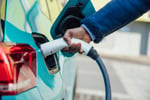The amount of tax the Government takes, on average, from company cars has increased by 9% year-on-year, newly-released data shows.
Actual revenues from company car tax and National Insurance Contributions (NICs) only increased by £70 million year-on-year, but that was despite a 5% fall in the number of company car drivers, according to the provisional figures.
HMRC took £1.55 billion in benefit-in-kind (BIK) tax and £630m in NICs from 940,000 company cars in 2016/17. But the following year, it collected £1.59bn in BIK (an increase of £40m) and £660m in NICs (£30m more), despite HMRC reporting 50,000 fewer cars (at 890,000).
It means the amount of tax the Government yields from a company car has, on average, increased by 9% or £209, from £2,319 in 2016/17 to £2,528 the following year. The increase also follows a 7% uplift in the average yield from 2015/16 to 2016/17.
At the start of the decade (2009/10), a company car was worth, on average, £1,680 in BIK and NICs revenues to the Treasury, some £1.63bn (£620m less), when there were 970,000 company car drivers – 80,000 more than in 2017/18.
The higher tax take between 2016/17 and 2017/18 can, in part, be explained by the increase reported in the taxable value over the same period.
The taxable value of the company car benefit was worth £4.8bn, up from £4.57bn the previous year, according to HMRC figures.
However, the vast majority of the revenue increase has been down to the annual two percentage point increase in BIK rates, first introduced in 2015-16 (in previous years there had typically been a one percentage point increase).
The higher incremental company car tax increases were decided in combination with the removal of the three percentage point diesel supplement, which was announced in the 2012 Budget and expected to take effect from April 2016.
However, shortly before it was due to be axed, the then Chancellor, George Osborne, announced he was delaying its removal until 2021 in light of ‘dieselgate’.
Two years later, Chancellor Philip Hammond, announced he was raising it to 4% from April 2018. He also announced that diesel cars that are RDE2-compliant would be exempt from the diesel surcharge.
COMPANY CAR DECLINE
Coupled with sweeping changes to salary sacrifice through the introduction of new Operational Remuneration Arrangements (OpRA), a lack of clarity over the future tax treatment of company cars and the impact of the WLTP (Worldwide harmonised Light vehicle Test Procedure), fleet decision-makers have warned of a growing move away from company cars to cash.
A Fleet News poll last autumn suggested that three-quarters (74.8%) of respondents were seeing an increasing number of employees choosing cash rather than a company car.
The dramatic decline in company car drivers could therefore be seen as sign of the increasing complexity of the fleet market.
Voluntary payrolling was introduced in 2016 to ease the reporting burden of BIK, with employers moving away from submitting P11D returns to collecting tax on company cars through payroll.
However, employers were not able, or required to, submit detailed information about company cars when using the new regime.
This changed from 2017-18, when employers payrolling car benefit were able to provide more detailed data about the cars being provided through their FPS (Full Payment Submission). But, HMRC said that providing this data was not mandatory until 2018-19.
As such, detailed information about the recipients of company cars through voluntary payrolling was not provided by many employers during the period covered by these statistics. Tax revenues from those cars are, therefore, not identifiable and are not included in the HMRC figures.
The expectation is that next year’s BIK statistics will include these company car recipients and their tax liabilities.
However, while insisting the 50,000 decline was ‘significantly’ down to the payrolling anomaly, an HMRC spokesman could not give a figure to back up this claim.
Lex Autolease head of fleet consultancy Ashley Barnett is sceptical. “I’m not convinced (the shortfall is down to voluntary payrolling),” he said.
Barnett points to statistics that sit behind the HMRC figures, such as new car registrations, where numbers have declined.
However, this could simply be due to employees and companies keeping cars for longer as they awaited BIK clarification, rather than a reduction in company cars.
LARGE DECLINE IN COMPANY CARS
Prior to these new company car figures being published, Barnett predicted a large decline in company car drivers.
He suggested a 2% decrease for 2017/18 (to 921,000 company car taxpayers), before falling 5% in 2018/19 to (875,000) and a further 5% in 2019/20 (to 832,000).
Alongside tax changes over recent years, Barnett also blames how decisions around the company car are being driven within companies.
He explained: “More recently, it has become a procurement decision rather than an HR-led one.”
Perk fleet customers see cash as an easier, cheaper option, but Barnett says the difficulty is they “struggle to find the cash allowance cost”.
In Lex Autolease’s experience, he says that considering the discounts fleets negotiate, cash will normally cost more.
“It’s about getting back to understanding what the purpose of the car is in terms of reward and some people have lost sight of that,” he said.
CO2 EMISSIONS FALL
Even the fact that company car drivers are choosing cars with lower CO2 values has failed to thwart the increase in revenues.
In 2016/17, the last year for which figures are available from HMRC, 87% of company cars emitted 134g/km of CO2 or less, an increase from 83% of cars in 2015-16.
More than a third (37%) of company drivers ran a car with emissions of 104g/km or less, up eight percentage points from the previous year.
There is an established strong trend in emissions reduction.
In 2002-03, 58% of company cars had CO2 values in excess of 165g/km; in 2015-16 this had fallen to 1%.
However, it remains to be seen what impact WLTP may have on average emissions.
All newly type-approved car models have been subject to the test since September 2017, while all other new cars had to be rehomologated by last September.
WLTP replaced NEDC (New European Drive Cycle), which had been criticised for failing to represent real-world fuel consumption.
The more accurate test has resulted in higher CO2 values, which will have a knock-on effect where average emissions will be concerned.
For more analysis, read a blog from Matthew Walters, head of consultancy and customer data services at LeasePlan UK.
What are the current benefit-in-kind (BIK) company car tax bands?






















Login to comment
Comments
No comments have been made yet.